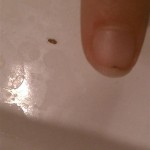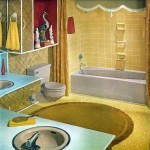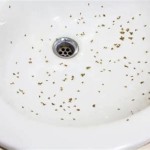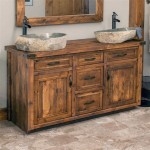How To Get Yellow Stains Out of a Bathroom Sink
Yellow stains in a bathroom sink are a common household problem, often stemming from mineral deposits, hard water, rust, soap scum buildup, and even certain types of toothpaste or cleaning products. These stains can detract from the overall cleanliness and aesthetic of a bathroom. Successfully removing these stains necessitates understanding their underlying cause and employing appropriate cleaning methods and solutions. This article details various techniques for tackling yellow stains, considering different sink materials and stain severity.
Identifying the Cause of Yellow Stains
Before commencing any cleaning process, identifying the cause of the yellow staining is crucial for selecting the most effective removal method. Mineral deposits and hard water are frequent culprits, leaving behind yellowish-brown discoloration. Hard water contains high concentrations of minerals like calcium and magnesium, which react with soap to form a stubborn film. Rust, originating from pipes or metal fixtures, can also cause yellow or orange staining, particularly around the drain. Certain soaps, shampoos, and toothpastes contain ingredients that can react with minerals in the water or the sink material itself, leading to discoloration over time. A thorough assessment of the stain's location and the bathroom's water quality can provide clues about its origin.
General Cleaning Supplies and Precautions
Regardless of the specific cleaning method chosen, certain general supplies are necessary. These include:
*Rubber gloves: To protect hands from harsh cleaning agents.
*Non-abrasive sponges or microfiber cloths: To avoid scratching the sink's surface. Abrasive materials like steel wool can damage the finish, making it more susceptible to future staining.
*Soft-bristled brushes: For scrubbing hard-to-reach areas, such as around the drain or faucet.
*Warm water: For rinsing and diluting cleaning solutions.
*Paper towels or dry cloths: For wiping surfaces dry.
Before applying any cleaning solution, it is essential to test it in an inconspicuous area of the sink to ensure it does not cause damage or discoloration. Wearing gloves is recommended to protect the skin from irritation caused by cleaning agents. Adequate ventilation is also necessary, especially when using strong chemicals. Avoid mixing different cleaning products, as this can create hazardous fumes.
Methods for Removing Yellow Stains
Several methods can be employed to remove yellow stains from a bathroom sink, ranging from gentle, natural solutions to more potent chemical cleaners. The choice of method depends on the severity and cause of the stain, as well as the material of the sink.
Baking Soda and Vinegar Paste
Baking soda is a mild abrasive and deodorizer, while vinegar is a natural acid that can dissolve mineral deposits and soap scum. This combination is effective for removing light to moderate yellow stains.
To use this method, mix baking soda and white vinegar to form a thick paste. Apply the paste to the stained areas of the sink and allow it to sit for 15-30 minutes. After the waiting period, scrub the paste using a non-abrasive sponge or cloth. Rinse thoroughly with warm water. If the stain persists, repeat the process or try a different method.
Lemon Juice or Citric Acid
Lemon juice contains citric acid, which is a natural bleaching agent and effective for dissolving mineral deposits and soap scum. For mild stains, lemon juice can be a gentle and effective alternative to harsher chemicals.
To use lemon juice, cut a lemon in half and rub the cut side directly onto the stained areas of the sink. Allow the lemon juice to sit for 30 minutes to an hour. Alternatively, you can create a solution of citric acid powder and water and apply it to the stains. After the waiting period, scrub the area with a non-abrasive sponge or cloth and rinse thoroughly with warm water.
Hydrogen Peroxide and Baking Soda
Hydrogen peroxide is a mild bleaching agent and antiseptic. When combined with baking soda, it creates a paste that can effectively remove stains and disinfect the sink.
To use this method, mix hydrogen peroxide and baking soda to form a paste. Apply the paste to the stained areas of the sink and allow it to sit for 30 minutes to an hour. Scrub the area with a non-abrasive sponge or cloth and rinse thoroughly with warm water. Exercise caution when using hydrogen peroxide, as it can lighten colored surfaces.
Commercial Bathroom Cleaners
Numerous commercial bathroom cleaners are specifically formulated to remove stains, soap scum, and mineral deposits. These cleaners often contain stronger chemicals than natural solutions and can be more effective for stubborn stains. When using commercial cleaners, it is essential to carefully read and follow the manufacturer's instructions.
Select a bathroom cleaner that is appropriate for the sink material. Apply the cleaner to the stained areas of the sink and allow it to sit for the recommended time. Scrub the area with a non-abrasive sponge or cloth and rinse thoroughly with warm water. Ensure adequate ventilation when using commercial cleaners to avoid inhaling harmful fumes.
CLR (Calcium, Lime, and Rust Remover)
CLR is a commercial cleaning product specifically designed to remove calcium, lime, and rust stains. It is particularly effective for removing stains caused by hard water and mineral deposits.
To use CLR, dilute it according to the manufacturer's instructions. Apply the diluted solution to the stained areas of the sink and allow it to sit for the time specified on the product label. Scrub the area with a non-abrasive sponge or cloth and rinse thoroughly with warm water. Always wear gloves and ensure adequate ventilation when using CLR.
Magic Eraser
Magic Erasers, made of melamine foam, are effective for removing various stains from surfaces. The microscopic structure of the foam acts as a mild abrasive, lifting stains without requiring harsh chemicals. It is important to test the Magic Eraser in an inconspicuous area first, as it can dull the finish of some surfaces.
To use a Magic Eraser, wet it thoroughly and squeeze out the excess water. Gently rub the Magic Eraser over the stained areas of the sink. Rinse the area with warm water.
Addressing Specific Types of Sink Materials
The choice of cleaning method should also consider the material of the bathroom sink. Different sink materials react differently to various cleaning agents. Using the wrong cleaner can damage the sink's surface, leading to further staining or discoloration.
Porcelain Sinks
Porcelain sinks are relatively durable but can be susceptible to staining and scratching. Avoid using abrasive cleaners or scouring pads, as they can damage the enamel finish. Baking soda and vinegar paste, lemon juice, and commercial bathroom cleaners formulated for porcelain are generally safe and effective. Testing any cleaner in an inconspicuous spot is always recommended.
Acrylic Sinks
Acrylic sinks are more prone to scratching than porcelain sinks. Use non-abrasive cleaners and soft sponges or cloths. Avoid using harsh chemicals, such as acetone or chlorine bleach, as they can damage the acrylic. Mild dish soap and water, baking soda and water paste, and commercial cleaners specifically designed for acrylic are suitable choices.
Stainless Steel Sinks
Stainless steel sinks are durable and resistant to staining, but they can develop water spots and discoloration. Use commercial stainless steel cleaners or a mixture of baking soda and water to remove stains. Always wipe the sink dry after cleaning to prevent water spots. Avoid using chlorine bleach, as it can damage the stainless steel.
Stone Sinks (Granite, Marble)
Stone sinks require special care to avoid damaging the natural stone. Use pH-neutral cleaners specifically formulated for stone surfaces. Avoid using acidic cleaners, such as vinegar or lemon juice, as they can etch the stone. Wipe up spills immediately to prevent staining. Seal the stone regularly to protect it from moisture and stains.
Preventing Future Yellow Stains
Preventing yellow stains from forming in the first place is the most effective way to maintain a clean and aesthetically pleasing bathroom sink. Several strategies can be employed to minimize the risk of staining:
*Regular cleaning: Clean the sink regularly with a mild detergent and water to prevent buildup of soap scum and mineral deposits. A daily wipe-down can significantly reduce the likelihood of staining.
*Dry the sink after each use: Drying the sink after each use prevents water spots and mineral deposits from forming. Use a clean, dry cloth to wipe down the sink and faucet.
*Use a water softener: If hard water is a problem, consider installing a water softener to reduce the mineral content of the water. This can significantly reduce the formation of stains and deposits.
*Choose appropriate cleaning products: Select cleaning products that are specifically designed for the sink material and avoid using harsh chemicals or abrasive cleaners.
*Address plumbing issues: If rust stains are a problem, address any underlying plumbing issues, such as corroded pipes or leaky faucets.
By identifying the cause of yellow stains, employing appropriate cleaning methods and solutions, and implementing preventative measures, it is possible to keep a bathroom sink clean, stain-free, and aesthetically pleasing.
No More Hard Water Stains How To Easily Clean Your Porcelain Sink In Minutes Vooki

How To Remove Stains From A Porcelain Sink Isavea2z Com

How To Get Rid Of Iron And Rust Stains Once For All Water Right

Removing Yellow Stains From A White Countertop Remove Countertops Laminate

Identifying Your Home S Water Staining Problems Easywater

How To Get Rid Of Bathroom Yellow Stains

How Do I Remove This Embedded Stain From Bathroom Sink Hometalk

How To Clean Yellow Stains From A Toilet Bowl Stain Solver

Yellow Hard Water Stains On Tub Hometalk

How To Remove Hard Water Stains In Your Bathroom
Related Posts







